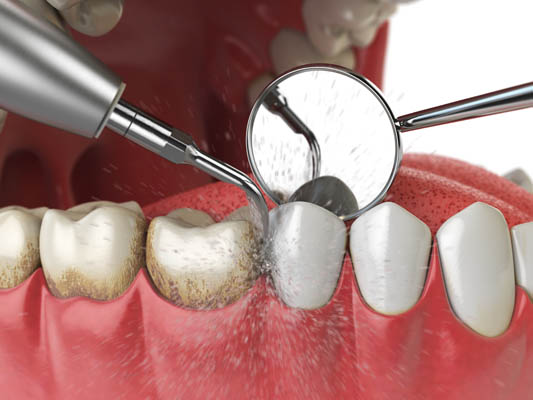Laser Scaling, Root Planing
Scaling and root planing is commonly referred to as a “deep cleaning”. This type of cleaning is diagnosed based on many factors. The first factor used to diagnose this cleaning is the amount of bone loss. Bone loss is measured using a periodontal probe. The probe is placed into the pockets surrounding each tooth and measured in millimeters. Healthy bone levels have readings from 1-4mm. Unhealthy bone levels are readings of 5mm and up. When pockets are deep and measure 5mm and up, patients are not able to remove the bacteria from those deep pockets and the bacteria sit around inside those pockets and will slowly cause more bone loss. When bone loss is evident, patients are then diagnosed with Periodontal Disease. Patients with periodontal disease are at risk for losing teeth. The second factor used to diagnose a deep cleaning is the amount of hard tartar build up underneath the gingival tissues. This hard tartar build up is called calculus and is detected in x-rays and upon oral examination. Calculus build up can occur above and below the gingival tissues and is what bacteria cling to and cause inflammation and bleeding. During a deep cleaning, the hard tartar is removed above and below the gums to help promote healing of the gingival tissues. The last factor used to diagnose a scaling and root planing is the amount of inflammation and bleeding upon probing. Bleeding gums are a sign of an abundance of bacteria below the gumline and would need to be removed with this type of cleaning. All of these factors play a role in diagnosing the right type of cleaning that will keep your oral health at it’s best.
Deep cleanings are performed by dental hygienists or dentists using an ultrasonic scaler. An ultrasonic scaler is a handpiece that vibrates to break off all the calculus around the root of the tooth and sprays out water to prevent overheating of the tooth. Hand scalers are also used to fine tune harder to reach areas under the gumline. A rinse called chlorhexidine and sometimes a diode laser is used to clean out the pockets around the neck of your teeth. Chlorhexidine solution is placed under the gums to aid in ridding the pockets of harmful bacteria. The laser aids in removing diseased gum tissue and helps promote healing of the gingival tissue by reattaching to root surfaces.
All of these things help promote healthier bone and gums to preserve our natural teeth.






